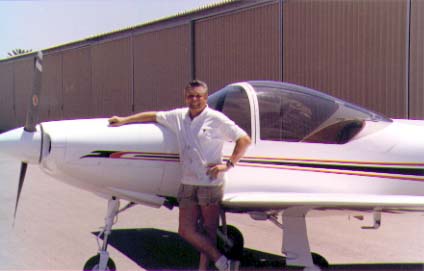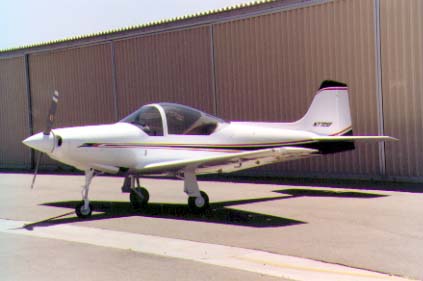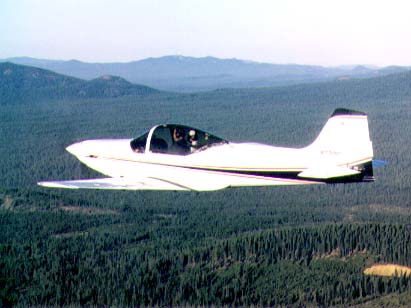First Flight:
Perry Burholm
![]()
First Flight:
|
|
by Alfred Scott
This article appeared in the December 1989 Falco Builders Letter. |
The 26th Sequoia Falco flew on November 14. The Falco was built by Perry Burholm, who lives in La Jolla, California. Perry started the plane in December 1982. He built all the the wood parts himself, made many of the simpler metal parts, but used kits for everything else.
Perry had previously built a Monerai sailplane and had spent most of his flying time in gliders. He owned a standard Libelle 201, one of the first fiberglass competition sailplanes.
In the first part of the construction, Perry made remarkable progress with the construction. He knocked out the wood parts for the plane in a surprisingly short time, which was doubly remarkable when you realize that he was working in a one-car garage. As time went by and as the plane took form, the space constraints slowed things down so that Perry eventually had to move the plane to the airport to finish it.
N772SF came in at 1141.6 lbs empty with the CG at 63.26", with a 160 hp IO-320-B1A and all painted in white, with black and red stripes.

Perry Burholm
With most of his flying in gliders and without much recent time, Perry wisely got Jim Slaton to do the first flight. Jim flew it on November 14 and put in about 45 minutes in the plane. The entire flight was done with the gear down, and Jim just took it through the routine stability checks of a first flight. With the gear down, you can't tell too much about a plane, but it needed a little right rudder, otherwise it flew nicely.
There was, however, just a tiny little problem with the engine, which kept trying to cut out. The first time this happened was at 800 to 1000 feet, right in the airport pattern, and it was an unsettling experience for Jim. The engine cut out for 3 seconds and then started running again normally.
Then 4 to 5 minutes later, the engine did the same thing, and it continued to do this for the rest of the flight. With more altitude and as he saw the regular pattern form, Jim became less concerned. It's not really clear to me what happened. Jim said that it was "just like you turned the key off" and thought all four cylinders were not firing. From the ground, Perry and a mechanic said they could hear the engine sputtering but thought the engine had not completely stopped running.
After Jim landed, the mechanic has given the engine a thorough going-over. The ignition switch was a suspect, but it checked out all right when they removed it. The mechanic did find that the injector nozzle on the No. 4 cylinder was clogged, and the plugs were fouled. Since that first flight, the plane has not flown again, but they have run the engine extensively on the ground without a problem. Perry hopes to get the plane back in air shortly, but he's the manager of a photographic lab and this is their busy season.

Over the years, we have had occasional problems with the main gear oleo shock absorbers. Sometimes there is a tiny pinhole leak in the weld at the top of the piston. The hole is normally so small that you can't even see it with your naked eye, but once you put pressure on the thing, the air finds its way out. Whenever we have this problem, we just replace the cylinder and put the defective cylinder on the shelf to be remanufactured next time we make those parts.
The other problem is with leaking under the valve. This normally shows up as a slow leak that lets the strut down over a one-to-three-day period. The cure for this is to use a little tool with some valve grinding compound to polish the face that the strut valve seats upon. This cure has worked for everyone except Perry Burholm who was jinxed. I've lost track of how many cylinders we had to send to poor Perry, and frankly I don't even want to think about it.
It was like a bad joke. Perry would polish the strut valve base, pump the cylinder up and come back the next day to find the struts bottomed out. He would pump the cylinders back up and spray them all over with Leak Check. Not a single indication of air leaking out, but the next day the cylinders would be flat. Then he submerged them in water, and later in a bath of oil, and never could see a single bubble come out. But when he put them back on the plane, the struts would go flat overnight. This type of thing can give you paranoia. Finally, the jinx ended and the struts held. Lordy, I hope we never have to go through that again.
